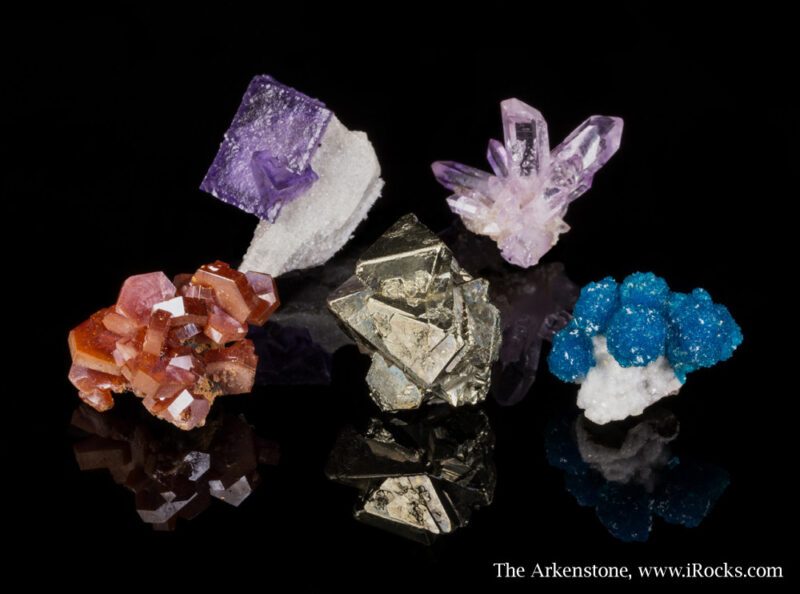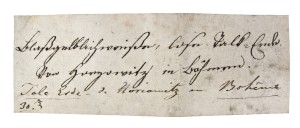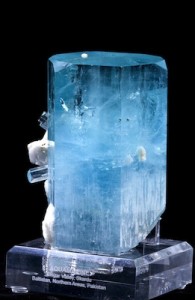Rock and Mineral Collecting for Beginners

Assembling little treasures of fine minerals can be a cost-effective and rewarding pursuit.
Collecting rocks and minerals is an exciting and rewarding hobby – full of fun, adventure, and hands-on opportunities to learn more about our world’s geology – all while building an important anecdotal and historical record.
For those of you beginners who are interested in exploring the amazing world of rocks and minerals – here are some tips for starting and maintaining an excellent collection, sure to bring you joy for years to come!
1. Do the research. Start close to home, by exploring your area’s geology – what minerals and rocks are present in your current locale? Are there any interesting geological features, or caches? By familiarizing yourself with the samples available near your home base, you can get used to using the tools of the trade, and practice your collecting skills, without venturing out into unfamiliar territory. Read The Wisdom Pocket Blog or check out some of our recommended reading lists.
2. Join a club. What better way to learn about collecting, than to connect with others who share your interest? Your local mineral collector’s club is a great place to learn more about your area, as well as the best approaches to collecting. There is no reason to recreate the wheel, when you can benefit from the knowledge of those who are more experienced – and collector’s clubs are also a great way to learn about other gatherings, events, and expeditions. The American Mineral Federation lists contact info for many local collecting clubs.
3. Gather the tools. If you decide you want to self-collect, acquire some basic equipment – though you don’t need to invest in expensive tools to get started. A great beginner’s toolkit should include safety glasses, a short-handled shovel, a good rock hammer or geologist’s pick, a mallet, a chisel, a bucket, work gloves, and a pair of sturdy boots – all of which can be found at most hardware stores, or your local tool shop. Don’t worry about advanced equipment – you can always add more sophisticated items to your toolkit as your collection of specimens grows, and hone your collecting technique.
4. Catalog your collection. As early as possible, begin keeping a catalog or database of your specimens. At the very least, maintain a record which identifies each specimen by a unique name or number, its mineral and varietal names, the year mined, and locale details (including the mine name, as well as specifics such as depth of find or level). Including the price paid for purchased specimens, and any other details regarding their previous history or display can also be helpful in determining the value of your collection, in future.

An old label from the collection of Sir Robert Ferguson, a Scottish noble. Keeping old labels add history and significance to specimens.
5. Keep the labels. When acquiring specimens from others, make sure you save any identifying labels, records, or information which accompanies them. The history of your specimens is what makes them unique – and, in some cases, distinguishes them as rare. This information adds to the story or provenance of your collection, and helps add additional interest and value to your collection.
6. Use reliable reference sources. It’s a great idea to invest in a good reference book, or other resource materials and publications. John Sinkankas’ book, Field Collecting Gemstones & Minerals is an excellent choice, as is the periodical publication The Mineralogical Record. For a list of other recommended sources on rock and mineral collecting, visit our reference page here.
 7. Learn how to properly trim and display your collection. Study the display of pieces you admire, and you’ll learn a lot about how to trim your pieces properly. By learning what helps make a quality specimen stand out, you’ll begin developing an eye for display which will help you trim and balance your display pieces, when you’re ready to invest in the tools. Contact us if you need advice or recommendations on cleaning or trimming fine mineral specimens. We also have a custom base lab located in The Arkenstone’s Dallas gallery. You can view examples of the bases on our custom base page.
7. Learn how to properly trim and display your collection. Study the display of pieces you admire, and you’ll learn a lot about how to trim your pieces properly. By learning what helps make a quality specimen stand out, you’ll begin developing an eye for display which will help you trim and balance your display pieces, when you’re ready to invest in the tools. Contact us if you need advice or recommendations on cleaning or trimming fine mineral specimens. We also have a custom base lab located in The Arkenstone’s Dallas gallery. You can view examples of the bases on our custom base page.
8. Limit the size of your mineral collection. It may sound counter-intuitive, but invest in a nice display cabinet or case, and limit your collection to what fits inside. This will help you select your specimens with discernment – and avoid the all-too-common scenario, in which a collection becomes unmanageable. There is no point in collecting pieces which lie unseen for years in storage – if you can’t find the space to show off your collection, you may as well not own it! And, if you find yourself in need of a good downsizing – don’t discount the opportunity for trade. You may find that by bundling your less desirable pieces, you are able to obtain one or two choice display specimens.
9. Develop your relationships. Many dealers travel far and wide, attending the best shows and symposiums, as well as visiting specific locales and interacting with other collectors. Once you’ve decided to define the focus of your collection, whatever that focus may be – develop your relationships with a few respected dealers. When you let them know what specimens you are interested in, you may find them willing to let you know when they come across a good deal, or an item of particular interest. Many dealers also maintain their own websites, which can be a wonderful resource for photos, articles, and news about recent finds.
10. Purchase quality. It may take you a while to develop an eye for fine quality stones and minerals – but as you learn more about the characteristics you are seeking, make sure you are buying the best you can afford. It is far better to own a collection with just a few stunning, high-quality display specimens, than to hold onto a large collection of mediocre pieces. Hold out for the finest specimens you can afford!
Above all else – have fun! Rock and mineral collecting is an adventure which allows plenty of opportunity for enjoyment. If you aren’t having a good time, you’re doing it wrong!
To view specimens of popular species, visit our Themed Galleries!